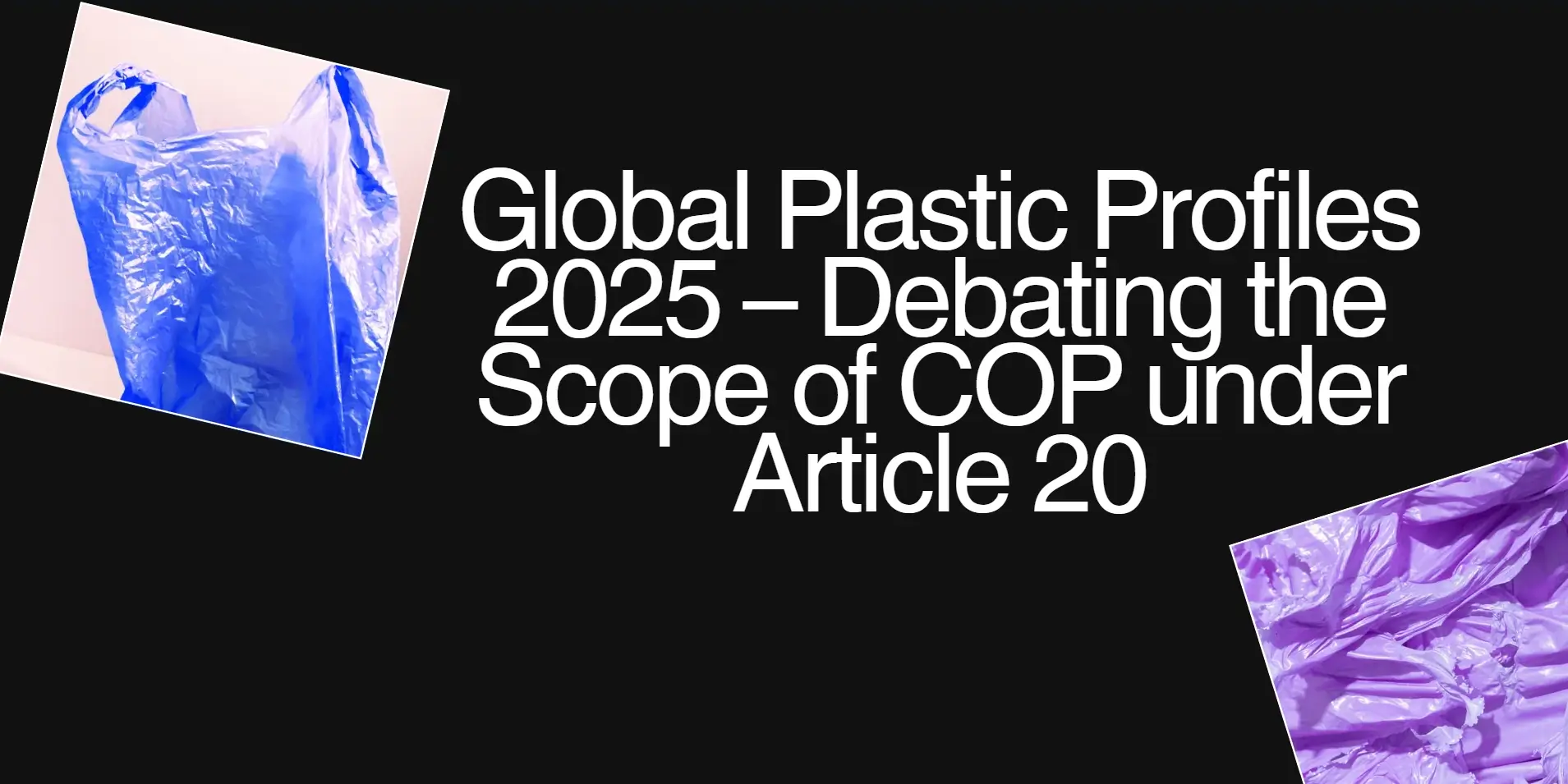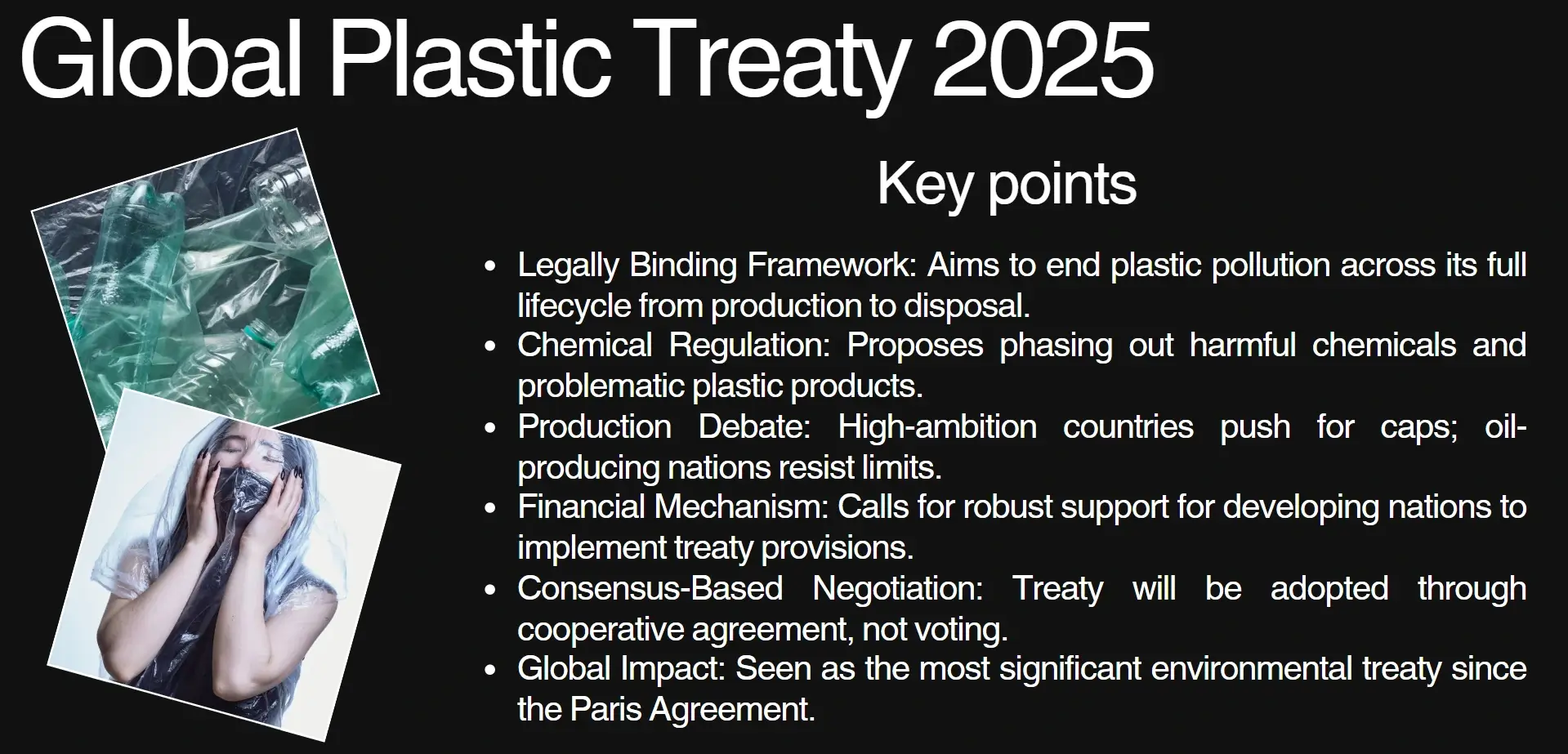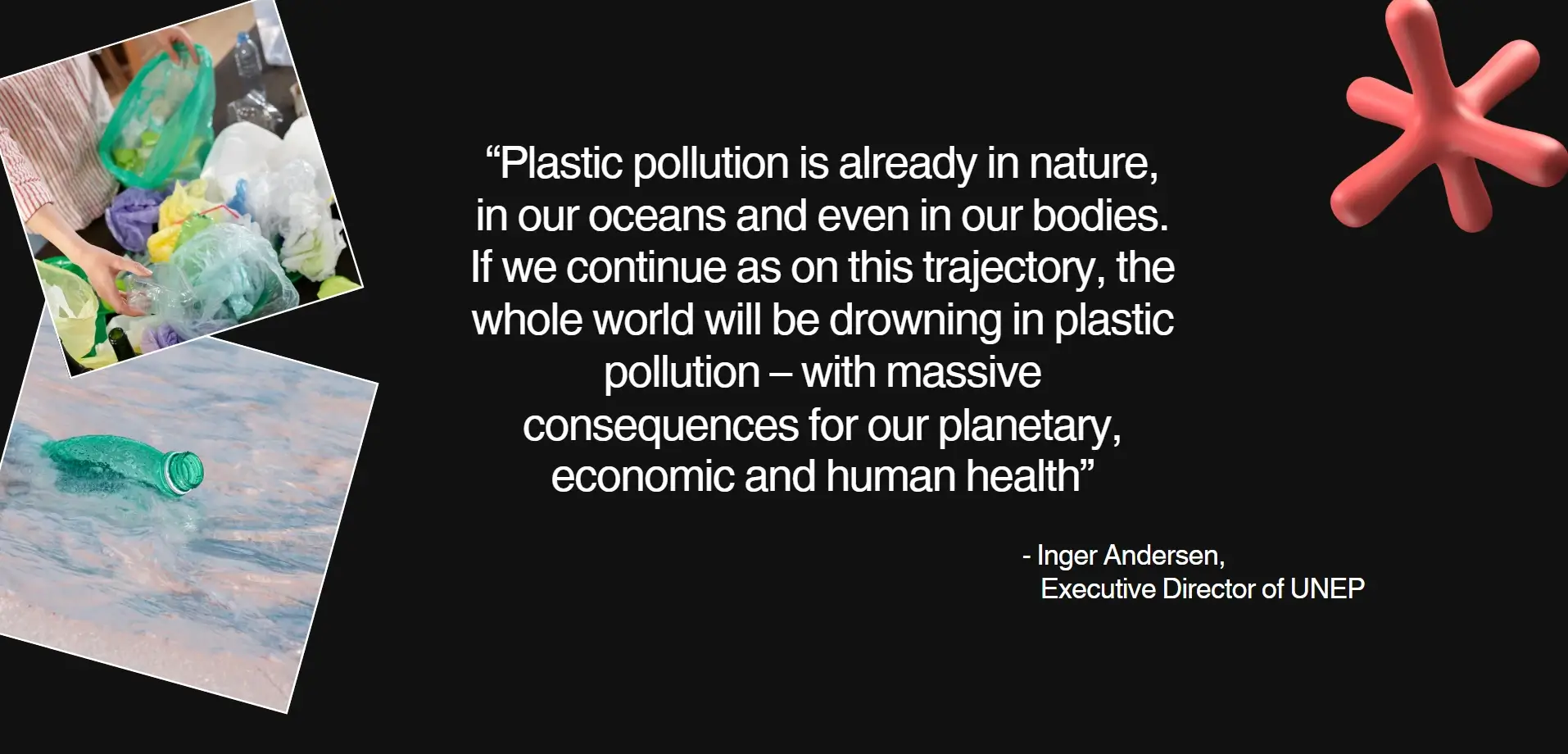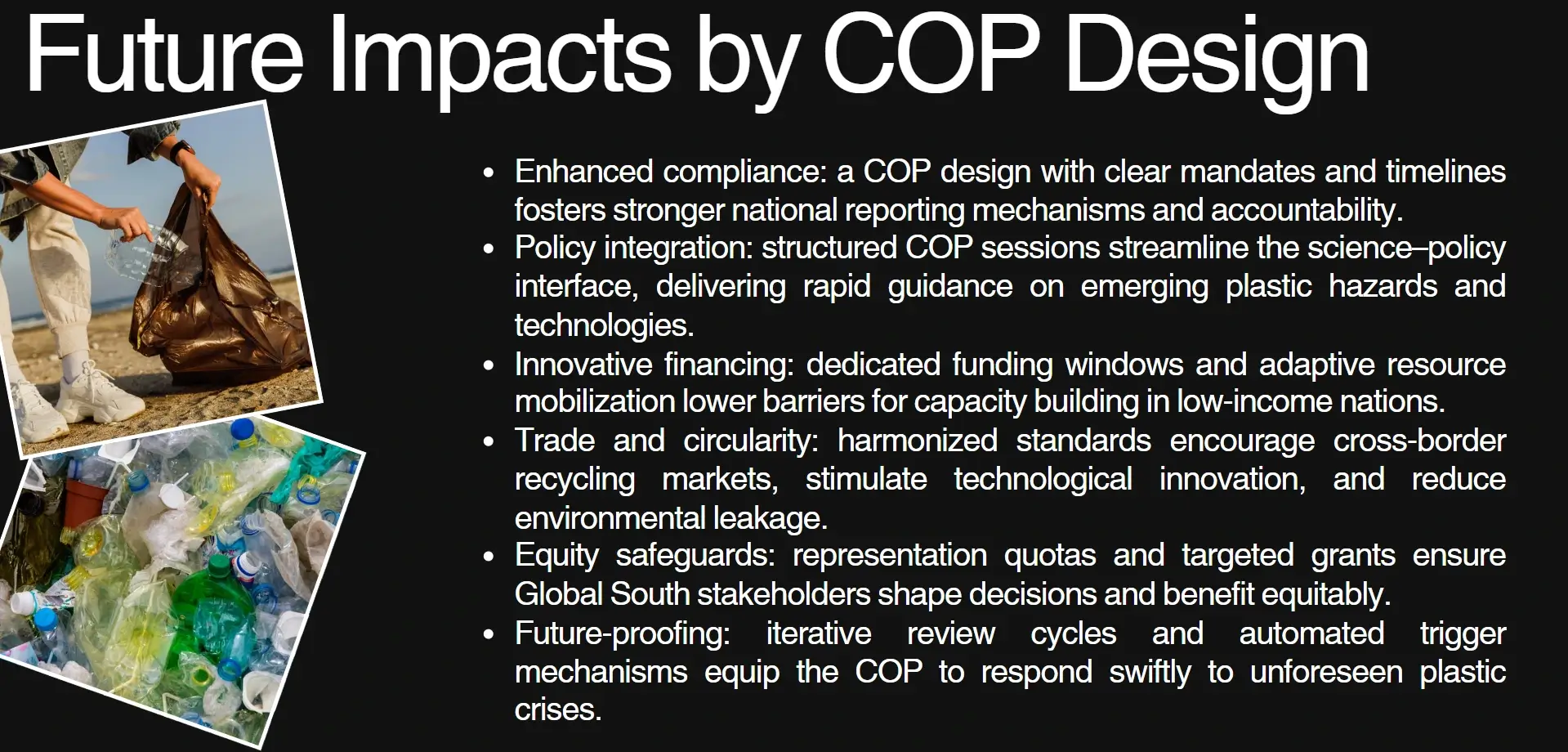Article 20 sets up the COP as the regulatory framework of the treaty and has been controversial as to what should its powers be, narrow or broad or international in nature.

In 2025, plastic pollution is globally recognised as a complex challenge requiring collective international action, which came in the form of a landmark Global Plastic Treaty, a bold precedent to governance on climate and other global environmental challenges. Article 20 is one of the defining provisions as it provides the foundation of the COP that is responsible for all major works. The advent of the COP represents a landmark institutional innovation, one similar to arrangements in climate and chemical treaties, aimed at coordinating national policies to guide shared ambition.But behind the agreement, there is an intricate negotiation terrain. Although each side agrees that there has to be a central authority, there is disagreement on the extent to which the powers of COP should be. The developing countries also have an interest in increased mandate in guaranteeing equity, financing, and technology transfer, whereas some high-income countries would like the scope to be narrower to safeguard national sovereignty. Such tensions are symbolic of larger cracks in environmental multilateralism,which have invited questions of legitimacy, efficacy, and inclusiveness.In this article, we shall examine the legal framework of Article 20, governance frameworks, and therefore the positions of the stakeholders concerning the scope of COP.
About the global plastics treaty Article 20
Article 20 of the GPT provides an institutional mechanismforthe implementation and formulation of the Conference of the Parties (COP).
Legality and Legislative Requirement
Article 20 is the procedural core of the treaty because it gives legal form to the COP as the highest decision-making body. It specifies the law duties such as conducting regular sessions annually, reading national reports on compliance and providing directives on plans of implementation. The provision employs many structural similarities to the previous environmental conventions; however, it constitutes greater adaptability to adaptive governance to changes that the plastic pollution trends often demand.
Role and Functional Scope of Institution
The COP mandatesrequire the organization to develop some protocols, monitor the progress, and transfer information among parties. It has the power to create subsidiary structures, including expert groups on microplastics or innovation pathways, as well as determine indicators used to determine treaty effectiveness. COP also guides the parts of UN bodies, non-state actors, and regional initiatives to coordinate them so that it acts as a hub of collective commitments as well as an enforcer.
Governance and Precedents
Institutionally, Article 20 resembles earlier models of the Paris Agreement (climate) and the Basel Convention (hazardous waste) in taking elements of rigid legal treatment mixed with a political ease. But unlike those earlier frameworks, COP under the plastic treaty is expressly mandated to technological equity and participation inclusivity, particularly by the developing countries and the vulnerable communities.

Treaty Enforcement Implications
Article 20 increases transparency, accountability and harmonization across borders by instituting an adequate legal and institutional basis of decision-making. Its effectiveness relies on how it can set up inclusive processes and how COP is not only technologically proficient, but also politically authorized.
Consensus on Necessity
Although the nature and high level of its responsibilities and functions have long been the subject of dispute, there is almost unanimous agreement that the COP constitutes a keystone of the governancearchitecture of the Global Plastics Treaty.
Coordination and Oversight Centralized
COP is a systematic platform where nations can check progress, identify what to target, and coordinate reduction policies on plastic. In its absence, the treaty would not have a coherent platform to keep track of its commitments, and also to share knowledge, especially in countries with less capacity to meet high targets.
Dignity and Accessibility
It develops political impetus and trust among various stakeholders such as governments, scientists, industry actors, and civil society through its convening power. The moral weight and the procedural legitimacy of the treaty are attributed to the COP,whichcan generate a consensus based on scientific evidence and policy innovations.
Forum of shared aspiration
The COP represents international aspirations more than a busy administration. It allows being flexible in terms of responding to new issues such as emerging pollutants or disruptive technologies. It is particularly essential in the role it plays in technical assistance and capacity building of the developing countries that are struggling to overcome transboundary plastic flows.
Negotiations Fault Lines
Although there is mutual support in terms of the Conference of the Parties (COP), there are still major fault lines on its powers as it exposes geopolitical tensions, distinct priorities and different visions of world governance.
Diverging Sovereignty Concerns
Countries with high incomes are sometimes wary of the authority of the COP as it can interfere supranationally. They promote a restricted mandate, concerning national jurisdiction and with the ability to make voluntary compliance mechanisms. This position is part of the wider geopolitical sensibilities of sovereignty, trade concerns and making internal policies in countries.
Global South Equity and Ambition
Conversely, developing countries are intent on a COP that is strong and thus has the potential of providing a binding commitment, fixing the finances and charging for delegation technology transfers. To many, it can be said that a strengthened COP is needed to curb inequality in the implementation capacity and achieve fair transitions out of plastic dependency.
Binding and Non-Binding decision
Dissent lies in whether the COP decisions are supposed to be of legal effect. Whereas others suggest advisory results and contingent rules, others are calling on binding standards to be put in place, particularly on transboundary waste and pollutant regulations. The implication of this debate on COP is the applicability of its impression and the ability to prevent non-compliance.
Dispute Resolution in the Private Sector
A second crack arises on the role of COP over the privately-owned organizations. There are parties that demand the mechanisms to control the multinational corporation and sort out the dispute in the industry, and others simply want to reduce COP to state-to-state relations, without spilling over any issues regarding trade rules and corporate lobbying.
Treading the waters of Political Legitimacy
The stress about the balance between authority and legitimacy is controversial. Vast mandates face the danger of politicization, and narrow delegations can weaken enforcement. Negotiators are still grappling over how to develop a COP process that achieves a balance and is participatory, based on science, and responsive without antagonizing important parties.
Models of Governance
The history of international environmental agreements provides important insights on how global environmental treaties should be shaped to govern the nature of the global plastics treaty especially the nature of the Conference of the Parties (COP) as stipulated in Article 20.

Polycentric Structure vs. Centralized Structure
Traditionally, the management of the environment has alternated between the forms of centralized and polycentric networks. The Montreal Protocol is more of a centralized nature with formidable powers vested on its controlling authorities to enforce and regulate compliance. By contrast, the Paris Agreement adopts polycentricism, which endorses national discretion but leaves the reporting systems in place across the world stage. These precedents place the discussion in the context of ideal structure of the COP: whether it has to create homogenising standards, or it can enable individual national trajectories.
Governing Flexibly and Adaptively
There are also precedents around the importance of institutional flexibility. The Basel Convention also came up with flexible compliance measures so that the parties would accommodate changing waste flows and new pollutants. When describing this as it pertains to plastics, the COP may be served by open governance where smaller groups within the committee can manage specialist subject matter such as marine micro plastics, chemical additives, and informal waste economies, and in turn enable the treaty to keep up with a rapidly changing world.
Multi-stakeholder Inclusion
The Minamata Convention and the Cartagena Protocol on trade issues are examples of how inclusivity can be powerful. They also incorporated science-policy conversations and NGO contributions, as well as indigenous knowledge systems, in formal decision-making. In the case of the Global Plastics Treaty, it is possible to incorporate comparable participant mechanisms into the structure of the COP, which can empower its jurisdiction and promote ownership of stakeholdersin it, particularly those in areas where plastic waste has an outsized impact.
Lessons to COP Design
These models of governance show that legitimacy, capacity and responsiveness are connected to one another. A strict COP can turn down the developing world, whereas an excessively divided one can splinter the influence. The difficult part is producing a structure that is simultaneously ambitious and accessible, based on pre-established models, but adapted to the plastic emergency.
Institutional Design
With the legal requirements, it should be designed to facilitate realistic decision-making across jurisdictions and sectors.
Structure and Governance Mechanism
The important aspect is a flexible but responsible form. It suggests a rotating president to preserve a healthy regional balance, thematic subcommittees on trade and innovation, and a standing secretariat to assist with implementation logistics. Such institutions have tounite scientific experience and provide an agenda for dynamics through sessions.
Funding and resources Mobilization
Financing options include a combination of member-assessed contributions, mixed financing mechanisms with multilateral development banks and other philanthropic contributions, and environments as well as environmental trust funds, in order to achieve operational sustainability. Clear budgeting and fair cost-sharing of the COP would be crucial in ensuring the legitimacy of the COP.
Non-State Actors participation
Socializing COPs, making use of NGOs, industry organizations, academia and indigenous peoples as formal members will enhance control, enhancing ownership by stakeholders. Transparency can be institutionalized through the use of mechanisms of the broadest possible public consultation and involvement of observers to diversify the sources of policy-related input.
Digital Infrastructure and Reporting
Treaty monitoring can be transformed with digital spaces of information-sharing, tracking of progress, and multilingual participation. The presence of a healthy science-policy interface is going to enable the COP to act based on adaptation to new developments and policy innovations.
Strategic Implications and future treaty implementation
The configuration and the powers of the Conference of the Parties (COP) created under Article 20 will have a major influence on the actualization of the ambition of the Global Plastics Treaty i.e., the transition of its dream into reality.

National Legal Reform and Compliance Architecture
These actions by the COP will determine the possibility of the member states to implement binding prevalent laws or rules given voluntary guidelines. Mandates with strong powers can trigger the standardization of production, packaging, and waste management laws, whereas weaker powers can create a patchwork of legal solutions and loopholes.
Surveillance and Adequate Resources
Strategic execution is based on strong measures of progress-tracking systems. The ability of COP to standardize measurement and data validation in different countries will be pivotal, particularly for the measurements that should evaluate a pollutant that is not visible, such as microplastics. This requires infrastructure development and open-access data.
Innovation, Tech Transfer, and Equity
The future implementation depends on the role of the COP as the promoter of innovation and equal access to solutions. Policies affecting R&D cooperation, intellectual property pooling and use of clean technologies will influence the diffusion in low-resource contexts to avoid the polarization of technological leaders and non-performing economies.
Globalization, Global Integration, and Trade
The advice of the COP on the harmonization of trade and plastic standards will influence international trade. An aligned structure is able to minimize non-tariff barriers and promote green product design. On the contrary, unclear rules can generate trade conflict, deteriorate cooperation.
Adaptive Capacity and Risk Management
The last parameter is that the structure of COP should allow responsive governance as the nature of new challenges, e.g., biodegradable plastic leaks, numerical governance of chemical additives, etc., unfolds. The incorporation of horizon scanning, risk analysis tools and multi-stakeholder foresight processes will confirm that the treaty stays applicable as the technology and the environment evolve.
Conclusion
Article 20 of the GPT is the crucial point of the process of a multilateral global campaign against plastic pollution. Although people are almost unanimously in support of its necessity, negotiations point to long-standing conflicts regarding the scope and limitations of its authority. The form and design of the COP will ascertain not only the coherence but also the equity, the legitimacy, and adaptive capacity of policies across jurisdictions as the treaty undergoes its implementation mode. A balanced approach to multiple priorities, probably involving sovereignty issues on the one hand and the desire for binding enforcement on the other, is going to demand a principled but pragmatic governance approach. Underlying the needs in future environmental agreements, COP as an institution, should come out as a proactive, inclusive institutionthat can effectively map ambition into reality.